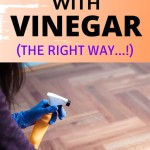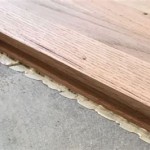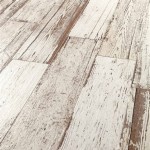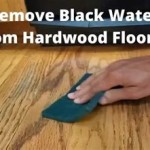How to Scrub Wood Floors: A Comprehensive Guide
Maintaining the beauty and longevity of wood floors requires consistent and effective cleaning. While sweeping and mopping are routine tasks, occasionally, a deeper scrub is necessary to remove embedded dirt, grime, and stubborn stains. This article provides a comprehensive guide on how to properly scrub wood floors, ensuring a clean and well-maintained surface without causing damage.
Before embarking on any floor cleaning project, it is essential to identify the type of wood flooring present. Different types of wood and finishes require specific cleaning methods and products. Understanding the characteristics of the floor will prevent accidental damage and ensure optimal results. Solid hardwood floors, engineered hardwood floors, and laminate floors each have distinct properties that influence the scrubbing process.
Furthermore, the type of finish on the wood floor also significantly impacts the choice of cleaning products and techniques. Surface finishes, such as polyurethane, create a protective layer on top of the wood, making them more resistant to moisture and stains. Penetrating finishes, like oil-based finishes, soak into the wood, offering less surface protection. When scrubbing, selecting products compatible with the specific finish is crucial to avoid dulling, scratching, or otherwise harming the floor.
Key Point 1: Preparation is Paramount
The first step in properly scrubbing wood floors is thorough preparation. This involves removing all furniture and obstacles from the area. Protecting adjacent surfaces, such as baseboards and walls, is also recommended to prevent splattering or accidental damage during the scrubbing process. Laying down drop cloths or using painter's tape can provide adequate protection.
Following the clearance of furniture, the floor should be swept or vacuumed meticulously. This step removes loose dirt, dust, and debris that could scratch the floor during scrubbing. Using a soft-bristled broom or a vacuum cleaner with a floor brush attachment is ideal, as these tools minimize the risk of damaging the wood surface. Particular attention should be paid to corners, edges, and areas under furniture, where dirt tends to accumulate.
Once the loose debris is removed, perform a preliminary examination of the floor to identify areas with stubborn stains or grime buildup. This allows for focused pre-treatment of these areas before proceeding with the overall scrubbing process. Identifying these problem areas beforehand will save time and effort in the long run and ensure a more consistently clean floor.
Spot treating stains before scrubbing is crucial for effective stain removal. Different types of stains require different treatments. For instance, water stains might benefit from a gentle application of vinegar and water solution, while grease stains might require a degreasing agent. Always test any cleaning solution on an inconspicuous area of the floor first to ensure it does not cause discoloration or damage.
Preparation also includes gathering all necessary cleaning supplies and tools. This ensures a smooth and efficient workflow. Necessary supplies typically include a bucket, a scrub brush with soft bristles, a cleaning solution specifically designed for wood floors, clean water, and absorbent towels or cloths. Having everything readily available will prevent interruptions and ensure the scrubbing process is completed efficiently.
Key Point 2: Selecting the Right Cleaning Solution and Technique
Choosing the appropriate cleaning solution is paramount for scrubbing wood floors effectively and safely. Harsh chemicals, abrasive cleaners, and excessive water can damage wood floors. Using a pH-neutral cleaning solution specifically formulated for wood floors is generally recommended. These solutions are designed to remove dirt and grime without stripping the floor's finish or causing discoloration.
Alternatively, a homemade cleaning solution can be created using mild ingredients. A mixture of water and a small amount of dish soap can be effective for light cleaning. White vinegar diluted with water is another option, although it should be used sparingly as excessive vinegar can dull the finish over time. Always consult the floor manufacturer's recommendations or a flooring professional for specific guidance on appropriate cleaning solutions.
The scrubbing technique is as important as the cleaning solution. Applying the solution sparingly is essential to prevent water damage. Over-wetting the floor can cause warping, swelling, or staining. The mop or scrub brush should be damp, not soaking wet. Wringing out excess moisture before applying it to the floor is crucial.
Using a soft-bristled scrub brush, gently scrub the floor in the direction of the wood grain. Avoid applying excessive pressure, as this can scratch or damage the finish. Focus on areas with visible dirt or stains, using small, circular motions to loosen stubborn grime. Overlapping strokes ensure that the entire surface is thoroughly cleaned.
For floors with textured surfaces or deep grooves, a specialized brush with slightly stiffer bristles may be necessary to effectively remove dirt from the crevices. However, caution should still be exercised to avoid damaging the wood. Regularly rinsing the scrub brush in clean water helps prevent re-depositing dirt onto the floor.
After scrubbing, immediately remove the dirty cleaning solution from the floor. Using a clean mop or cloth, wipe up any excess water or cleaning solution. This step is crucial to prevent water from seeping into the wood and causing damage. Multiple passes with the mop or cloth may be necessary to ensure the floor is thoroughly dry.
Key Point 3: Drying and Maintenance After Scrubbing
Proper drying is essential to prevent water damage and maintain the integrity of the wood floor. After wiping up the excess cleaning solution, allow the floor to air dry completely. Opening windows or using fans can help speed up the drying process. Avoid walking on the floor until it is completely dry to prevent streaks or footprints.
The time it takes for the floor to dry will depend on several factors, including the humidity level in the room, the type of cleaning solution used, and the type of finish on the floor. Generally, it is recommended to allow at least a few hours for the floor to dry completely. If the floor feels damp to the touch, it needs more time to dry.
Once the floor is dry, inspect it for any remaining stains or areas that require additional attention. If necessary, repeat the spot treatment process for stubborn stains. Avoid scrubbing the entire floor again unless absolutely necessary, as excessive scrubbing can wear down the finish over time.
Maintaining wood floors after scrubbing involves implementing preventative measures to minimize the need for frequent deep cleaning. Using doormats at entrances will help trap dirt and debris before they are tracked onto the floor. Regularly sweeping or vacuuming the floor will remove loose dirt and dust, preventing it from becoming embedded in the surface.
Placing felt pads under furniture legs will protect the floor from scratches and dents. Avoid wearing shoes with hard soles indoors, as these can also damage the floor's finish. Promptly cleaning up spills and messes will prevent stains from setting in. Following these simple maintenance tips will help keep wood floors looking their best for years to come.
Regularly applying a wood floor cleaner and polish can help maintain the floor's shine and protect the finish. Choose a product specifically designed for the type of wood floor and finish. Follow the manufacturer's instructions carefully when applying these products. Over-application can lead to buildup, which can dull the floor's appearance over time.
The frequency of scrubbing wood floors depends on several factors, including the amount of foot traffic, the presence of pets, and the overall level of dirt and grime accumulation. In general, scrubbing wood floors should be done sparingly, typically only a few times per year. Routine sweeping, vacuuming, and damp mopping should be sufficient for maintaining the floor's cleanliness between scrubbings. Over-scrubbing can damage the floor's finish and shorten its lifespan.

How To Clean Hardwood Floors Reviews By Wirecutter

The 5 Best Ways To Clean Hardwood Floors Chet S Cleaning

How To Clean Hardwood Floors Like A Pro

How To Clean Hardwood Floors Without Damaging Them

The Right Way To Clean Wood Floors

How To Clean Wood Floors Carefully And Deeply O Cedar

How To Clean And Shine Hardwood Floors Fast Easy Tips

Diy Buffing Techniques For Homeowners Mr Sander

Wood Floor Deep Cleaning Re Coat Union Nj

How Do You Deep Clean Wood Floors Chem Dry







